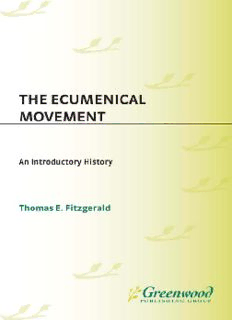
The Ecumenical Movement: An Introductory History (Contributions to the Study of Religion) PDF
Preview The Ecumenical Movement: An Introductory History (Contributions to the Study of Religion)
The Ecumenical Movement Recent Titles in Contributions to the Study of Religion Noble Daughters: Unheralded Women in Western Christianity, 13th to 18 th Centuries Marie A. Conn Confessing Christ in a Post-Holocaust World: A Midrashic Experiment Henry F. Knight Learning from History: A Black Christian's Perspective on the Holocaust Hubert Locke History, Religion, and Meaning: American Reflections on the Holocaust and Israel Julius Simon, editor Religious Fundamentalism in Developing Countries Santosh C. Saha and Thomas K. Can Between Man and God: Issues in Judaic Thought Martin Sicker Through the Name of God: A New Road to the Original of Judaism and Christianity Joel T. Klein Gods of Our Fathers: The Memory of Egypt in Judaism and Christianity Richard A. Gabriel Human Dignity and the Common Good: The Great Papal Social Encyclicals from Leo XIII to John Paul II Richard W. Rousseau, S.J. Searching for Meaning in the Holocaust Sidney M. Bolkosky Christianity, the Other, and the Holocaust Michael R. Steele Return: Holocaust Survivors and Dutch Anti-Semitism Dienke Hondius David Colmer, translator The Ecumenical Movement An Introductory History THOMAS E. FITZGERALD CONTRIBUTIONS TO THE STUDY OF RELIGION, NUMBER 72 PP A TS/f^TGP) Westport, Connecticut lr¥^iyMiyll\ London Library of Congress Cataloging-in-Publication Data FitzGerald, Thomas E., 1947- The ecumenical movement: an introductory history / Thomas E. FitzGerald. p. cm.—(Contributions to the study of religion, ISSN 0196-7053 ; no. 72) Includes bibliographical references (p.) and index. ISBN 0-313-30606-0 (alk. paper) 1. Ecumenical movement—History. I. Title. II. Series. BX6.5.F58 2004 280'.042'09—dc22 2003058159 British Library Cataloguing in Publication Data is available. Copyright © 2004 by Thomas E. FitzGerald All rights reserved. No portion of this book may be reproduced, by any process or technique, without the express written consent of the publisher. Library of Congress Catalog Card Number: 2003058159 ISBN: 0-313-30606-0 ISSN: 0196-7053 First published in 2004 Praeger Publishers, 88 Post Road West, Westport, CT 06881 An imprint of Greenwood Publishing Group, Inc. www.praeger.com Printed in the United States of America The paper used in this book complies with the Permanent Paper Standard issued by the National Information Standards Organization (Z39.48-1984). 10 9 9 8 7 6 5 4 3 21 For Kyriaki with love Our movement towards the visible unity of the churches is one filled with great joy and some sorrow. We know that the road to reconcili ation is not an easy one. Yet, we also know that Our Lord is truly with us. He is our way. He is our life. He travels with us as he walked with his disciples on the road to Emmaus. In calling us to be His dis ciples, Christ calls us to join with Him in His ministry of reconcilia tion and renewal. Let us lift the veil of division from our face that we might move together from glory to glory. To Christ be all glory, honor, and worship together with the eternal Father and the life- giving Spirit, now and forever, and unto ages of ages. Amen. Ecumenical Patriarch Bartholomew of Constantinople Service of Prayer National Council of Churches of Christ New York October 27,1997 Contents Preface ix Acknowledgments xi 1 An Introduction to the Ecumenical Movement 1 2 Jesus Christ and the Beginning of the Church 15 3 Historic Church Divisions 33 4 First Steps Toward New Relationships 59 5 Early Church Unity Movements 81 6 The Founding and Development of the World Council of Churches 103 7 The Entrance of the Roman Catholic Church 127 8 Concerns and Contributions of the Orthodox Church 145 9 Tensions and Accomplishments in the Churches of the Reformation 169 10 Theological Dialogues for Reconciliation 193 11 Regional and Local Ecumenism: Perspectives from the United States 223 Epilogue 237 Appendix J 241 viii Contents Appendix IJ 243 Appendix JJI 245 Appendix JV 247 Bibliography 259 Jndex 269 Preface The ecumenical movement has been a part of my life as long as I can remember. I was raised in a family that appreciated both the tradition of Eastern and Western Christianity and in a neighborhood where good friends belonged to different churches. As I walked to elementary school and later to high school, I passed many church buildings. Eventually, my curiosity got the best of me and I explored them. Often, I experienced the worship and met with the pastors of these communities of faith. As an undergraduate and graduate student, the issue of church divisions and unity was a thread uniting many of my academic and vocational interests. As a theologian, teacher, and pastor, I have been a part of many prayer services, dialogues, and expressions of social concern reflecting the ecu menical commitment of the churches. With friends, colleagues, and parishioners, I have experienced the tragic consequences of church divi sions and the joyous appreciation of church unity. This book has a very modest intention. It is designed to introduce the topic of the ecumenical movement to a wider audience, especially those studying the Christian Church and Christianity in the past century. The ecumenical movement is a process through which many of the Christian churches are seeking to overcome past divisions and to be visibly united in common faith, worship, and service. Throughout the twentieth century, the many expressions of the ecumenical movement have affected all aspects of church life, its worship, theology, mission, and service in every part of the world. The movement has touched the lives of most Christians wherever the church is present. It is a movement of reconciliation that has by no means been completed.
Description: